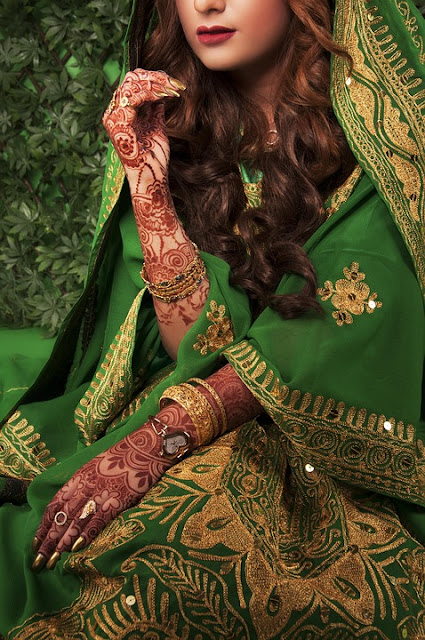10 Interesting Fun Facts About Heena You Didn't Know
With the wedding season fervor at its pinnacle, we love participating with various ceremonies. Ethnic clothes and jewellery are fished out from forgotten corners of our wardrobes or we indulge in some delightful shopping. Take a look at one such look we created recently here. One of the most fun and coveted ceremony during Indian weddings - primarily Hindu, Sikh and Muslim communities is "Mehendi" or "Heena" ceremony. In this ritual, the bride's and her female friends/family members hand and feet are adorned with heena patterns. Also, dholak beats and lots of dancing follow this delightful ceremony.
Mehendi or Heena has a lot of cultural significance in Indian traditions. Also, it is applied during various occasions- Karva Chauth, weddings and more. Women also use it to apply on hair for its nourishing benefits, you can read them here. Did you know, Mehendi has a lot of significance and uses across various cultures?
Here are 10 Interesting Facts About Heena You Didn't Know:
According to research, the word Henna has its origin in the Arabic word Al-Hinna.
The use of Heena originated in ancient Egypt around 5000 years ago. Although, its exact history in India is a little unclear. According to some research, Heena was introduced to India by Mughals around 12th century AD. Others claim that, Heena was used for its medicinal purposes even before Mughal invasion around 4th or 5th century.
Cleopatra used Heena to amplify her beauty and during ancient times. And fingernails of mummies were painted with henna for a good afterlife. In addition, heena designs featured in many ancient rituals.
During Hindu weddings, when applied on a bride's hands & feet, symbolizes beauty and joy. Whereas often Moroccans paint doors with henna to usher prosperity and chase away evil. Heena art is extremely popular in India.
The bark and seeds of the plant are used in Unani medicine. The oil can be used to cure skin disorders, headaches, baldness, prickly heat and more.
In rural North Africa, twigs from the plant are used as toothpicks and to keep teeth and gums healthy.
Heena has anti-bacterial and anti-fungal properties. It is often applied to form a protective layer on skin and around the tender fingernail area. Besides, if you are looking at knowing how long does heena last, it is temporary & lasts 8/10 days.
Years ago, Egyptian men and women dipped their fingers into henna. This resulted in red tipped fingers. It was also considered inappropriate to leave the house without such application of heena.
Heena was often used by dessert dwellers as a cooling agent and applied on hands and feet. This helped to ward off the ill effects of heat.
The Yemenite and North African Jewish communities also apply Heena during weddings. Heena is called Chenah in Hebrew. In addition, within the small Jewish Yemeni culture, the prenuptial ceremony is called "hinne".
The bark and seeds of the plant are used in Unani medicine. The oil can be used to cure skin disorders, headaches, baldness, prickly heat and more.
In rural North Africa, twigs from the plant are used as toothpicks and to keep teeth and gums healthy.
Heena has anti-bacterial and anti-fungal properties. It is often applied to form a protective layer on skin and around the tender fingernail area. Besides, if you are looking at knowing how long does heena last, it is temporary & lasts 8/10 days.
Years ago, Egyptian men and women dipped their fingers into henna. This resulted in red tipped fingers. It was also considered inappropriate to leave the house without such application of heena.
Heena was often used by dessert dwellers as a cooling agent and applied on hands and feet. This helped to ward off the ill effects of heat.
The Yemenite and North African Jewish communities also apply Heena during weddings. Heena is called Chenah in Hebrew. In addition, within the small Jewish Yemeni culture, the prenuptial ceremony is called "hinne".






Sorry, aajkal jyada active nahi hu, ghar per guest hain to time hi nahi milta 😊
ReplyDeleteHeena k baarey me itna details mujhy nahi pata tha per mujhy bahut accha lagta hai,jab bhi mauka milta hai main mehndi jarur lagwa leti hu 💕💕
that's so nice. do share some pictures with us
DeleteI have heard henna before, but know nothing about its cultural importance.. The designs I see on the models forearms ,and hands are Very attractive. So intricate and small ,it appears you need an artist to apply. Also I wonder how long this takes to do as much as model displays. Again you have taught me something new. If I keep following you ,I will become very well informed. Thank you for all the effort you put into your blogs. So entertaining , and besides everything else , you are Very pretty to look at. Now I am blushing . Bye . I wish for you peace , and safety on your many journeys.
ReplyDeleteThnx so much Buck
Delete